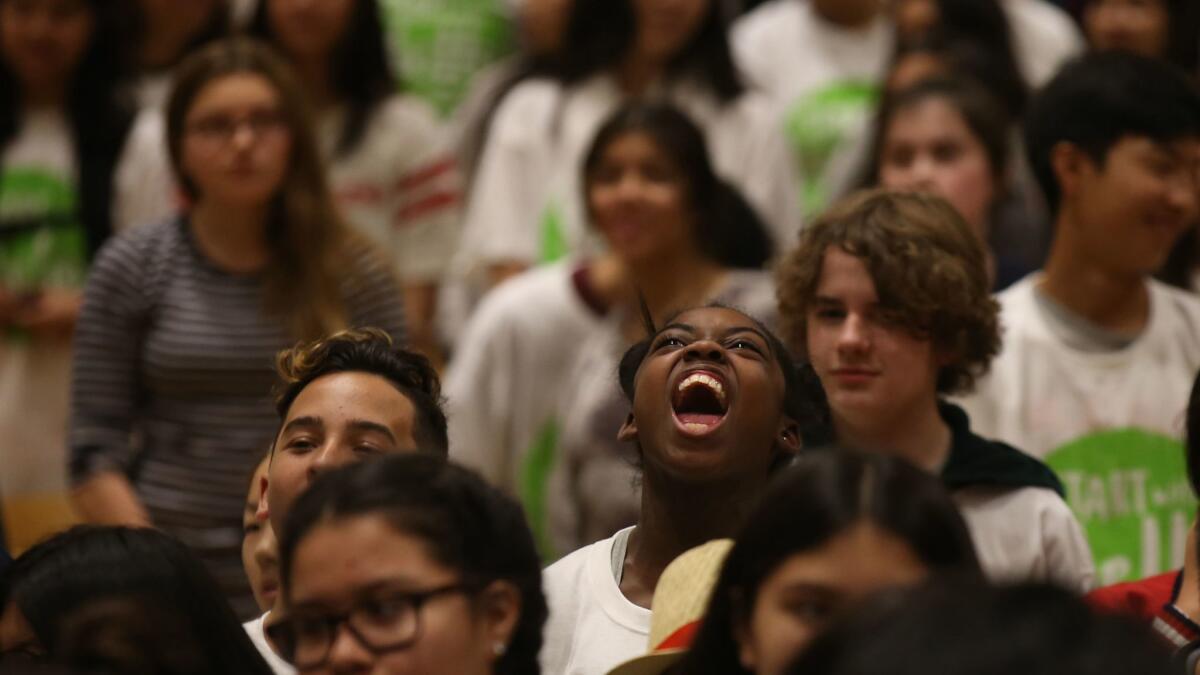One-fifth of L.A. public high school students said they’d been bullied last year

Add fighting bullying to the long list of priorities for which the nation’s second-largest school system has good intentions but sluggish follow-through.
One in 5 Los Angeles high school students and 1 in 4 elementary students said they had been bullied last school year, according to a survey conducted as part of a newly released internal audit.
As for efforts to curb bullying, at one campus, the person in charge of handling bullying complaints was “not aware that she was appointed for this role,” the report says.
And although schools were supposed to keep bullying complaint logs, at nearly every campus the audit examined they were either not in use or were not up to date.
Although the extent of bullying found by the L.A. Unified’s Office of Inspector General is not necessarily out of line with national figures, the audit suggests that students are getting less help than they should.
“Most teachers and staff did not receive high quality training on bullying prevention on an annual basis,” the report says. Schools try to address bullying but fall short, to varying degrees.
In addition, the district, according to the audit, has fewer staff members overseeing anti-bullying efforts than other school systems with similar goals.
Part of the problem is a lack of clarity about what to do. Some of the report consists of auditors and administrators disputing or trying to agree on the best approaches. The district conceded the need for better training.
Teaching has become increasingly complicated, with instructors already required, among other things, to get annual training to recognize and report sexual misconduct, to deliver specialized instruction to students learning English, and to stay up to date on academic goals, teaching methods and technology.
But curbing bullying also is important, said Ron Avi Astor, a professor at USC’s schools of social work and education.
“Part of a school’s purpose is to create A-plus human beings, who get along and speak to each other in respectful ways,” said Astor, who has analyzed and conducted research on bullying around the world. “If you are able to create a school that makes kids happy, where there’s a good school climate, it not only becomes fertile ground for creating civic, democratic and communal values but also for strong academic gains.”
Anonymous student surveys, Astor said, offer the most reliable bullying data, and should be conducted at every school annually. If L.A. Unified made this happen, it could track progress and determine which schools are models and which ones need help.
So far, L.A. Unified has not taken this step, even though the school system has long considered itself a groundbreaker in addressing the social and emotional challenges of students going back to the mid-1980s, when a Fairfax High teacher started Project 10 to counsel gay and lesbian students and keep them from from dropping out.
More recently, the district has embraced “restorative justice,” which deals with student conflict and misbehavior through counseling rather than traditional forms of discipline, such as suspension. The goal is to emphasize personal responsibility and the importance of making amends. But that effort, too, has been problematic, according to faculty and some administrators, and the inspector general’s office intends to review this as well.
The bullying audit was completed by the beginning of October, according to district insiders. It was released Monday following a public-records request by The Times. At least some of the four-month delay apparently was to give administrators an opportunity to respond to criticisms.
The survey conducted as part of the audit also found that:
- In elementary school, equal numbers of boys and girls said they’d been bullied. In high school, it was more boys than girls.
- Bullying declines somewhat as students move into higher grades.
- The scene of bullying gradually shifts from the playground to online and in the classroom, and older students are less likely to tell an adult.
- About 5% of students said they had bullied a peer during the current school year, and more than a third of that group said they had taken part in cyberbullying — online bullying that might involve such things as publicly posting a hurtful or threatening remark on social media.
About 83% of students at 228 schools answered all or part of the survey questions. About 61%, or 48,206 students, completed the survey, allowing for full analysis.
To read the article in Spanish, click here
Times staff writer Sonali Kohli contributed to this report.
More to Read
Sign up for Essential California
The most important California stories and recommendations in your inbox every morning.
You may occasionally receive promotional content from the Los Angeles Times.






![[20060326 (LA/A20) -- STATING THE CASE: Marchers organized by unions, religious organizations and immigrants rights groups carry signs and chant in downtown L.A. "People are really upset that all the work they do, everything that they give to this nation, is ignored," said Angelica Salas of the Coalition of Humane Immigrant Rights. -- PHOTOGRAPHER: Photographs by Gina Ferazzi The Los Angeles Times] *** [Ferazzi, Gina -- - 109170.ME.0325.rights.12.GMF- Gina Ferazzi/Los Angeles Times - Thousands of protesters march to city hall in downtown Los Angeles Saturday, March 25, 2006. They are protesting against House-passed HR 4437, an anti-immigration bill that opponents say will criminalize millions of immigrant families and anyone who comes into contact with them.]](https://ca-times.brightspotcdn.com/dims4/default/34f403d/2147483647/strip/true/crop/1983x1322+109+0/resize/840x560!/quality/75/?url=https%3A%2F%2Fcalifornia-times-brightspot.s3.amazonaws.com%2Fzbk%2Fdamlat_images%2FLA%2FLA_PHOTO_ARCHIVE%2FSDOCS%2854%29%2Fkx3lslnc.JPG)




